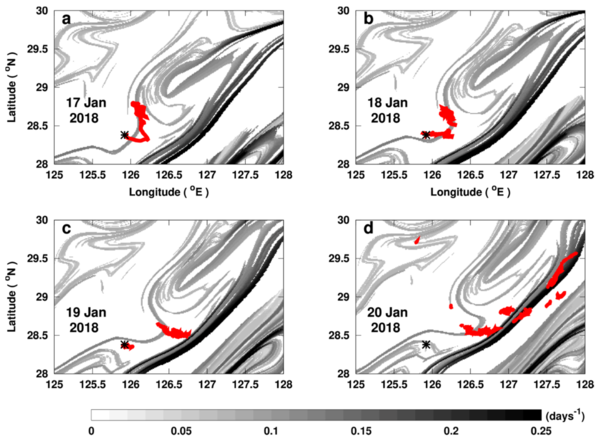FSLEs help to forecast oil spill dispersion
Image of the Month - December 2021

Oil spills are among the most damaging and frequent marine pollutions. Their detection, by Synthetic Aperture Radar or optical sensor satellites are now fully operational. However, to mitigate the induced damages onshore, putting the right antipollution equipments at the right place and time is still of foremost importance.
Lagrangian techniques have for principle to "follow" the fluid particles along their horizontal passive movements (advection). Finite-sized Lyapunov exponents are among them, and have been routinely computed from altimetry geostrophic current velocities for several years now. They show high-resolution frontal structures acting as transport barriers. A "tracer" (e.g., a patch of oil) released close to a front of high values of Lyapunov exponents will be attracted in its direction. Moreover, the tracer will be stretched along this front line while being contained by it.
Testing this with real oil spill examples and near-real-time surface currents to anticipate the fronts deformations shows that in the open ocean for light oil (at the surface) the altimetry-computed lyapunov exponents provide with an insight on the dispersion of the oil for the coming days. The technique might also be applied to other such pollutants or to biological films -- it should depends on the material density, though.
Swot will bring high resolution oceanic features over the whole ocean, even very close to the coasts.
See also:
- Image of the Month, December 2020: Dispersion in the Mediterranean Sea
- Image of the Month, October 2008: Thread-like structures extracted from altimetry
- Applications: oceanography / multi-sensors
- Applications: Oceanography / submesoscale circulation
- Data: FSLE in delayed-time or 20-days delay
- Missions: Swot
Reference
- Fifani, G., A. Baudena, M. Fakhri, G. Baaklini, Y. Faugère, R. Morrow, L. Mortier, F. d’Ovidio, 2021: Drifting Speed of Lagrangian Fronts and Oil Spill Dispersal at the Ocean Surface. Remote Sens. 2021, 13, 4499. https://doi.org/10.3390/rs13224499




